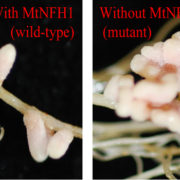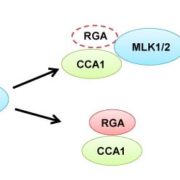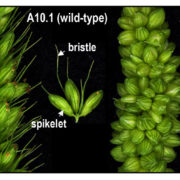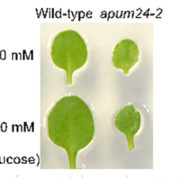
Nodule Symbiosis: Cleavage of Bacterial Signals Affects Nodule Shape
Research, The Plant Cell, The Plant Cell: In a NutshellCai et al. investigate the function of a Medicago truncatula enzyme (MtNFH1) that cleaves nodulation signals of symbiotic Sinorhizobium meliloti bacteria. Plant Cell (2018). https://doi.org/10.1105/tpc.17.00420.
By Jie Cai, Zhi-Ping Xie and Christian Staehelin
Background: Nitrogen-fixing rhizobia…

Conservation of Genomic Imprinting during Wheat Polyploidization
Research, The Plant Cell, The Plant Cell: In a NutshellYang et al. discover conservation of genomic imprinting between closely related Triticum and Aegilops species. https://doi.org/10.1105/tpc.17.00837
By Guanghui Yang and Mingming Xin
Background: Genomic imprinting causes genes to be differentially expressed depending on their parent-of-origin, which…

Combining Forces for Hypocotyl Elongation: Histone Modifications, GA, and the Circadian Clock
Research, The Plant Cell, The Plant Cell: In a NutshellZheng et al. discover proteins that mediate interactions between gibberellins and the circadian clock https://doi.org/10.1105/tpc.17.00830
By Han Zheng and Yong Ding
Background: Hypocotyl elongation helps the shoot emerge from the soil surface. The gibberellin (GA) signaling protein RGA inhibits…

Wax Protects Rice from Drought Stress
Research, The Plant Cell, The Plant Cell: In a NutshellWang et al. investigate how two proteins work oppositely to regulate wax contents and drought stress response in rice https://doi.org/10.1105/tpc.17.00823
By Zhenyu Wang and Qingyun Bu
Background: Rice is a staple food for world populations and its production is threatened by drought stress. Cuticular…

Changing Fates: Brassinosteroids Underlying Yield Potential in Millet
Research, The Plant Cell, The Plant Cell: In a NutshellYang et al. reveal a role for brassinosteroids in spikelet and floral meristem fate in Setaria viridis. The Plant Cell (2017) https://doi.org/10.1105/tpc.17.00816
By Jiani Yang and Andrea L. Eveland
Background: Grass inflorescences show extensive morphological diversity between species, due…

Snapshot of a TF Network in Plants
Research, The Plant Cell, The Plant Cell: In a NutshellLi et al. investigate a transcription factor network that transmits environmental signals to regulate secondary metabolism in plants. The Plant Cell https://doi.org/10.1105/tpc.17.00805.
By Baohua Li and Daniel Kliebenstein
Background: Plants produce specialized secondary metabolites to survive…

Ribosome Production Under Surveillance
Research, The Plant Cell, The Plant Cell: In a NutshellMaekawa et al. find a ribosome production monitoring system in Arabidopsis thaliana Plant Cell (2017) https://doi.org/10.1105/tpc.17.00778
By Shugo Maekawa, Tetsuya Ishida, Shuichi Yanagisawa
Background: Protein is produced by ribosomes consisting of a number of proteins and several RNAs (ribosomal…

Roots Respond to Aboveground Far-Red Light
Research, The Plant Cell, The Plant Cell: In a Nutshellvan Gelderen and Kang et al. investigate the root response to Far-Red light detection in the shoot. The Plant Cell (2017). https://doi.org/10.1105/tpc.17.00771
By Kasper van Gelderen and Ronald Pierik
Background: Sunlight is the energy source for plants, however, when plants grow closely together…

The Phytohormone Ethylene and Transcriptional Repression
Research, The Plant Cell, The Plant Cell: In a NutshellZhang et al. investigate histone deacetylase in the ethylene response. Plant Cell (2017). https://doi.org/10.1105/tpc.17.00671
By Fan Zhang
Background: Ethylene is the only gaseous hormone in plants, and is a key hormone controlling plant growth and resistance to stress. Epigenetic mechanisms are…

